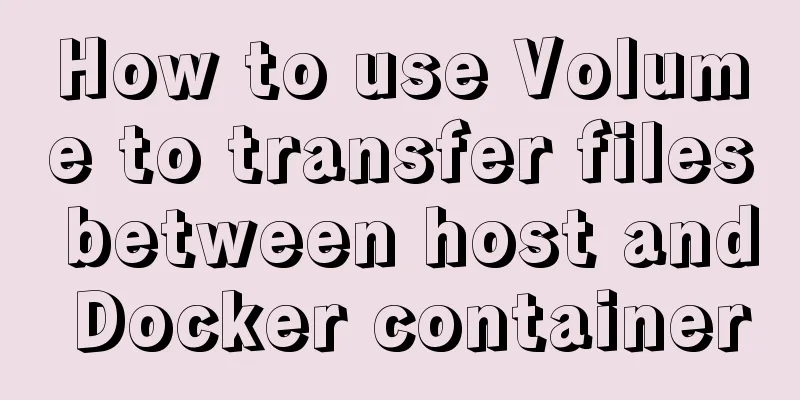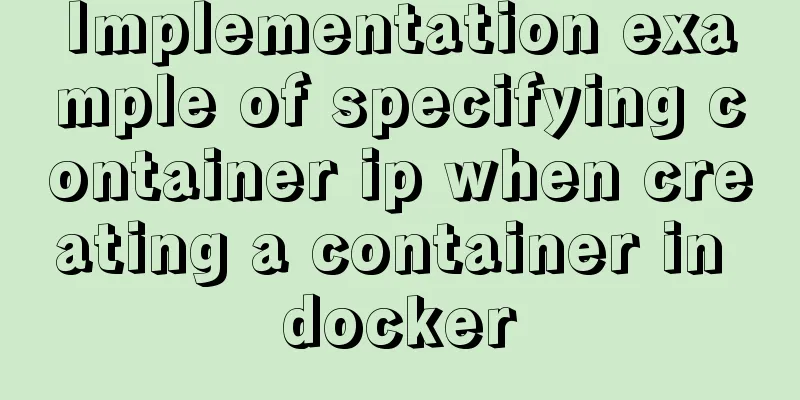How to use Volume to transfer files between host and Docker container

|
I have previously written an article about file transfer between Docker containers and local machines. However, this method is relatively cumbersome. After checking the official documents on data management, I found that using volume to achieve file transfer between the host and the container is more efficient. In fact, it is to mount the local directory to the container. There are three official methods: Manage data in Docker, Here we only introduce the operation of using volumes: Use volumes 1. Use Volume to transfer files between the host and the container. In the official documentation, you can see that you can create a volume using the following command: Create a volume: $ docker volume create my-vol Note that this command is not available for all Docker versions:
After creation, you can view detailed information: $ docker volume inspect my-vol
Note that the directory corresponding to this Mountpoint is the directory we use to transfer files between the host and the container. Then you can use the volume when you start a container using run:
You can see that the data volume just created is mounted to the hostdata directory in the container through the -v command. At this time, when we add files to the hostdata directory in the container, we can see them in /var/lib/docker/volumes/my-vol/_data on the host. Similarly, when we add files to this directory on the host, we can also see them in the hostdata of the container. I copied the nginx file to the directory used for exchange in the host, and after entering the container, I can also view it in the hostdata directory:
Similarly, copy the file to the hostdata directory in the container and you can view it in /var/lib/docker/volumes/my-vol/_data on the host. Here I create a file testfile in the container and write to it: This is container write!, then go back to the host to view it, and use vim in the host to add to it: "This is host write!", and go back to the container to view it.
2. Use data volume container. I have seen people use data volume containers to share data between multiple containers. The process is as follows: 1. First create a data volume container dbdata, and create a data volume in it and mount it to /bdata:
You can use docker volume ls to view the volume with a random name. 2. Then, you can use --volumes-from in other containers to mount the data volumes in the dbdata container. For example, create two containers, db1 and db2, and mount the data volumes from the dbdata container:
3. Then at this time, any writes in the /dbdata directory in any of the three containers can be seen in the other containers.
In the figure, the testfile file is created in the dbdata container and written to "dbdata container write!". Then, it is viewed and written to in the db1 container "db1 container write!". Then, it is viewed and written to in the db2 container "da2 container write!". Finally, it is viewed back in the dbdata container. 4. Then you can also mount multiple data volumes through multiple –volumes-from, and then it also provides methods for backup and recovery, which can be found in large quantities on the Internet. 3. Why not use data volume containers? I have seen many articles about data volume containers, and they are all similar. Then I thought about it and found that there was no need to use a data volume (maybe I didn't think it through enough). As mentioned above, the data volume container is used to share data among multiple containers, but this method can be achieved by mounting the same local directory. For example, I can mount the my-vol data volume created in the first step to both the db3 and db4 containers.
In the figure, I mounted the my-vol data volume to db3 and db4, and then I was able to find the previous data files in them. I wrote the testfile file in the db4 container and also viewed it in the db3 container. That is to say, I can also share data in multiple containers by mounting a data volume, and the files added in the host directory can also be viewed in all containers. If you want to back up, you can just copy the folder locally on the host, which is more convenient. 4. Why use data volume containers? However, the data volume container has another good function, which is to specify the local directory to mount. In the first point, we create a data volume named my-vol. The directory where the data volume is stored locally is: /var/lib/docker/volumes/my-vol/_data. It can be seen that this name is very long and inconvenient to operate. The data volume container can be used to solve this problem. For example, I created a directory on the host specifically for storing files for interaction between the host and the container. That is to say, if I want to transfer any files to the container in the future, I can just copy the files to this directory:
I did not find any command in the official documentation that allows you to specify the local directory corresponding to the volume when creating a data volume using docker volume create (maybe I didn't read enough). But I just want to use the /usr/local/datadb directory, what should I do? At this point, the role of the data volume container comes into play. You can create a data volume container and mount the directory on the data volume container:
In the figure, I created a so-called data volume container, and used the -v parameter to mount the /usr/local/datadb directory of the host into it. Then I created a file testfile in the container and wrote "HAHAHAHA" to it, and then viewed it on the host. Then when other containers are created, you can use –volumes-from to mount the data volume container. When you want to transfer files to the container, just copy them to the /usr/local/datadb directory. Conversely, when the container transfers files to the host, just copy them to the mount directory in the container. As for backup, just assign a copy to the host /usr/local/datadb, and mount it again for recovery. But there is a problem. All the above volume mounting operations use the run command to create a new container. As for whether it is possible to mount the running container directly, I searched for a long time and only found one article about this, but I have not verified it. If you are interested, you can check it out: https://www.jb51.net/article/157179.htm The above is the full content of this article. I hope it will be helpful for everyone’s study. I also hope that everyone will support 123WORDPRESS.COM. You may also be interested in:
|
<<: Detailed explanation of the use of state in React's three major attributes
>>: MySQL 5.7 installation-free configuration graphic tutorial
Recommend
Realization of real-time file synchronization between Linux servers
Usage scenarios For existing servers A and B, if ...
MySQL 5.7.25 installation and configuration method graphic tutorial
There are two types of MySQL installation files, ...
Detailed explanation of the use of DockerHub image repository
Previously, the images we used were all pulled fr...
How to use sed command to efficiently delete specific lines of a file
Preface Normally, if we want to delete certain li...
CSS3 transition to achieve underline example code
This article introduces the sample code of CSS3 t...
MySQL database optimization: detailed explanation of table and database sharding operations
This article uses examples to illustrate the tabl...
When MySQL is upgraded to 5.7, WordPress reports error 1067 when importing data
I recently upgraded MySQL to 5.7, and WordPress r...
arcgis.js controls the display range of the map body to automatically bounce back when it exceeds the area (implementation ideas)
Table of contents background Effect Ideas backgro...
A quick solution to accidentally delete MySQL data (MySQL Flashback Tool)
Overview Binlog2sql is an open source MySQL Binlo...
A brief discussion on several specifications of JS front-end modularization
Table of contents Preface The value of front-end ...
DOM operation implementation in react
Table of contents Previous words Usage scenarios ...
Example of MySQL auto-increment ID exhaustion
Display Definition ID When the auto-increment ID ...
Detailed explanation of MySQL user rights management
Table of contents Preface: 1. Introduction to Use...
How to use javascript to do simple algorithms
Table of contents 1 Question 2 Methods 3 Experime...
JavaScript to achieve simple drag effect
This article shares the specific code of JavaScri...




















